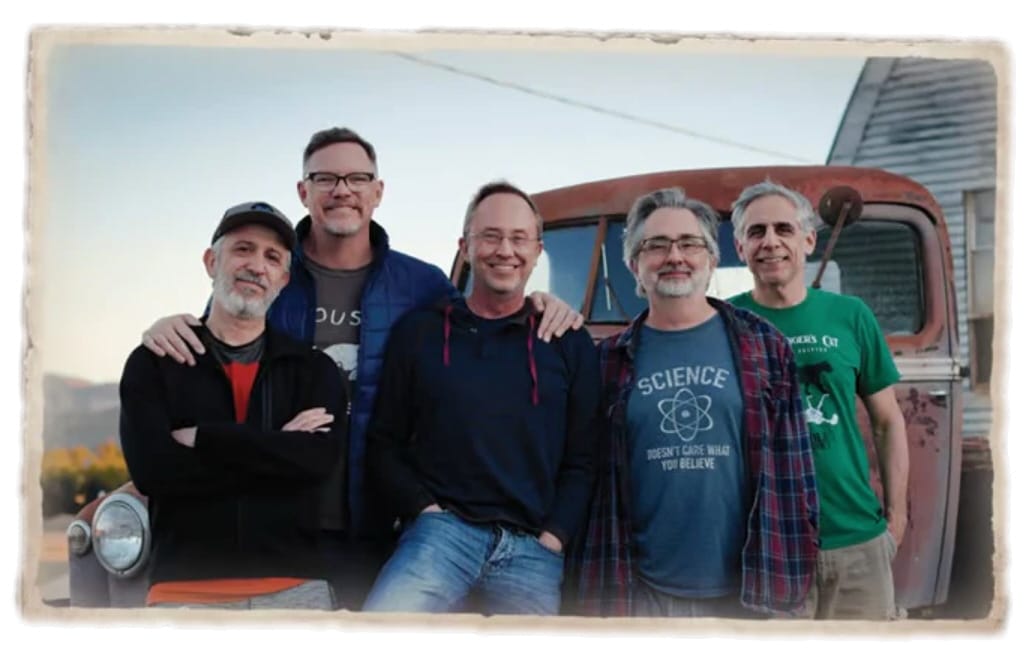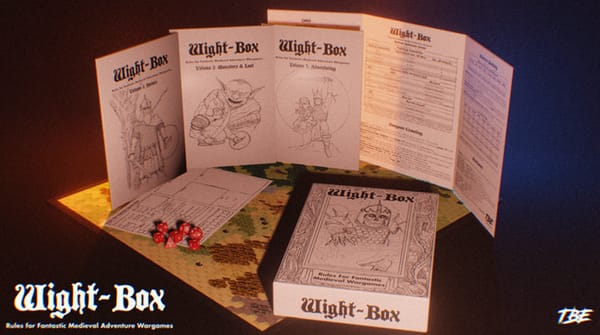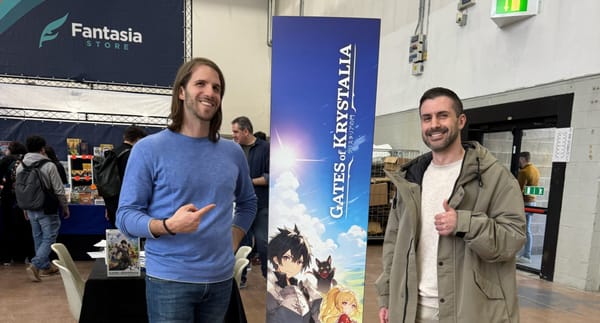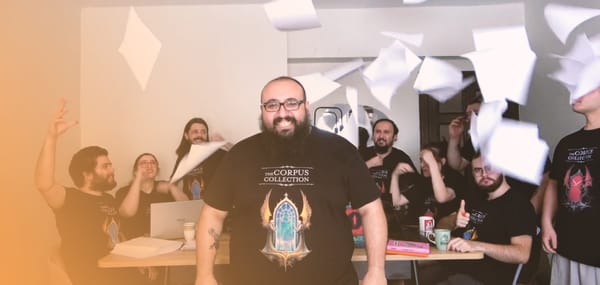From Stream of Annihilation to Industry Icons: The Rise of Beadle & Grimm’s

When it comes to premium experiences in the TTRPG world, few names resonate as strongly as Beadle & Grimm’s. Born from a shared passion for storytelling, friendship, and the magic of Dungeons & Dragons, this company has redefined what it means to engage with tabletop RPGs.
With a team that includes actor and gaming evangelist Matthew Lillard, Beadle & Grimm’s quickly became known for their lavish, immersive boxed sets—full of maps, props, handouts, and accessories that bring campaigns to life in ways few imagined possible.
Since launching their first product, the team has not only earned the trust of Wizards of the Coast—a feat many dream of—but also expanded into collaborations with iconic properties like Avatar Legends and Star Trek.
They’ve done so with style, creativity, and an unwavering commitment to craftsmanship. Their Kickstarter campaigns consistently stand out for their polish, clever marketing, and deep connection with the fan community. Each launch feels less like a product drop and more like a cultural event in the RPG space.
In this exclusive interview Bill Rehor and Jon Ciccolini pull back the curtain on Beadle & Grimm’s creative and business journey. They discuss everything from their first spark of inspiration to the logistics of building high-end crowdfunding campaigns, the value of physical storytelling tools in a digital age, and their firm stance on the role of AI in the creative process.
This is a must-read for anyone who dreams of turning game-night passion into a full-fledged brand—and doing so with boldness, integrity, and a lot of heart.
Onwards!
Let’s go back to the beginning - how did Beadle & Grimm’s first come to life? What was the initial spark?
Bill Rehor (Founder, Chief Operating Goblin): We’ve all been great friends for a good long time. We’re creative people who love to collaborate, and we’ve come together many times over the years on various projects - a theater company, some film projects, things like that. With role playing games being such an integral part of each of our lives, it was only a matter of time before we turned our energies towards that as a collaborative effort.
Do you remember the moment when you first thought, “Let’s turn our experience as players into a business”?
BR: We all attended D&D’s Stream of Annihilation event in Seattle in 2017. Meeting the amazing people there who were working and thriving in the RPG space really turned a light on for us. That experience gave us the first glimpse of the possibilities.
Your company name comes from your in-game characters - how much did those early campaigns shape your design philosophy?
Jon Ciccolini (Founder, Chief Production Goblin): Ha! Probably too much! Our campaigns played fast and loose with lore and rules. On our very first D&D product we learned quickly that if you’re creating a licensed product you have to get those right. Luckily our reviewers at Wizards of the Coast were both patient and supportive.
What was your journey like from longtime gamers to full-time creators and entrepreneurs?
BR: When we started the company, we all still had our day jobs and ran the company on nights and weekends. The real journey came when we made the leap and committed ourselves to it full time - that’s where it went from a hobby to our livelihood.
We try to keep our same guiding principles intact, but there’s no question that business decisions carry a little more weight when your family is depending on the company’s success.
What were some of the biggest challenges when starting the company, and how did you overcome them?
BR: The founders brought a lot of previous business experience to the table, including a lot with small businesses and startups, so we weren’t flying completely blind. But the gaming industry, and the gaming fanbase, is its own unique ecosystem.
Learning how and where to reach our fans and how to best incorporate their feedback has been an ongoing process. Some of our biggest setbacks have come when we didn’t take the time to really understand what people wanted from us, and we keep learning from that.
How did Matthew Lillard join the team? Was he there from the beginning or did he come on board later?
JC: There from the beginning, and a driving force in our creation and launch. He’s hard to ignore.
Has having a Hollywood actor in the team helped build the brand’s visibility? What impact has Matthew had on Beadle & Grimm’s?
JC: Sure, he’s increased our brand’s visibility, but his rousing speeches to our Warehouse Goblins in the loading dock are where his true value lies.
What was your first interaction with Wizards of the Coast like? How did you convince them to trust you with their license?
We came to the table with over 100 years of combined experience DMing and playing, coupled with a variety of other skills like web programming, marketing, project and vendor management, and, of course, Matthew’s significant reach.
In your opinion, what was the key factor that persuaded Wizards to let you develop official D&D content?
JC: When we realized they were going to let us in the room we didn’t just go to them with a Powerpoint deck on the Premium Edition we wanted to create. We actually created one. We took the risk of hiring artists and cartographers, and constructing the prototype box and DM screen and maps and handouts.
Your collaboration with Magpie Games on Avatar Legends: Voyage of the Unity is another major milestone. How did that partnership come about?
Charlie Rehor (Founder, Supreme Marketing Goblin): We’d known each other from conventions, and of course admired their work on Avatar Legends and other projects. So we’d been talking about doing something together for years before we brainstormed this project together.
What were those initial conversations with Magpie like? Did you already have a concept in mind, or did it evolve together?
CR: We knew broadly that we wanted to bring our premium boxes to the Avatar universe, but coming up with the time period, setting, and stories was very much collaborative. They’re the experts on this world, obviously, and we’re grateful for all the help they’ve given us.
What were the biggest differences between working on Avatar Legends and working with D&D material?
CR: One of the biggest differences is that Avatar conflict resolution doesn’t really lend itself to battle maps, which is one of our favorite things in D&D Premium Editions. That said, maps are always great. They ground the game, give the players something to reference and strategize with. So we definitely are including maps of the Unity itself, the seas it's sailing, and the locations it's visiting.
Your Kickstarter campaigns are known for their quality and polish. Can you walk us through how you plan one, behind the scenes?
BR: Really appreciate the compliment, but they don’t feel polished from our side! We have a seasoned team and there’s a great deal of preparation leading into it, but everything changes once the backers start contributing their ideas.
As Eisenhower famously said, “Plans are useless, but planning is indispensable.” You try and predict what people will respond to, and that creates a sound foundation, but then there’s an enormous amount of listening and adjusting once the campaign goes live.
How much time do you typically spend preparing a campaign before launch? How do you divide responsibilities across your team?
Not sure how to exactly quantify time spent but the advice is to spend as much time as needed to present a compelling product. Customers are taking a leap of faith by backing your campaign, so you need to present whatever is needed to show them that this project is worth their trust! We divide responsibilities by strengths - some of us are more technically inclined than others (we won’t name names).
To what extent do you rely on your own community and reach when launching a campaign?
A great extent. We’ve spent years building a community of game enthusiasts that have been kind enough to allow us to email them with updates on new projects. Hopefully our products convince them that they want to hear more.
Do you use paid advertising or performance marketing to boost your Kickstarter presence?
JC: Yep. Moreso when we’re launching a KS that we think will appeal to a new set of fans that might not know us as well - like for our Star Trek Murder Mystery and Escape Room games.
How important are influencers to your campaigns? How do you choose who to work with?
JC: It’s really on a case by case basis. For our Star Trek Murder Mystery game, Captain Liam Shaw is a main character, and since we consider Todd Stashwicka friend, it just made a ton of sense to work with him on that one!
Do you follow a fixed marketing strategy or does each campaign require a completely different approach?
JC: Every campaign has been pretty different. Ring of Chaos was targeting fantasy board gamers. Murder on the Titan-A and Mary Celeste for Star Trek and Murder Mystery fans. Everybody Dies Volume 1 for D&D fans and fans of Faster Purple Worm, Kill Kill. Finally, Voyage of the Unity for Avatar fans.
Each campaign came with different levels of built in fan bases. Jeez, you’d think we’d make this a little easier on ourselves?
Looking back, which campaign would you consider your biggest success — and which one taught you the most?
Each of us would probably give you a different answer on this - there’s so many factors like expectations, who the project lead was, did it reach a new audience, etc. If we’re learning from our mistakes (a very questionable if) then the first one should have taught us the most.
Do you think physical props and immersive accessories have more value now than ever before? How has your perspective evolved?
JC: For me personally, yes. I have a bi-weekly game where we meet in the same room, around a table, and not online or virtually, and I count the days until that game. I want the piece in my hand. I want to look at the map on the table and the dice hopping off books.
How do you view the rise of artificial intelligence in the context of TTRPG content creation?
BR: AI art is a lot like Vecna. On the one hand, it’s intimidating, immoral, and disturbing to look at. On the other hand, it can still be defeated if we all stick together.
Have you experimented with AI tools for writing, designing, or generating content like NPCs, lore, or visuals? What worked and what didn’t?
We have a strict “No AI” policy in our agreements with our artists, cartographers, etc.
What opportunities — and risks — do you see in the growing role of AI in the tabletop space?
JC: It may be that it’s only a matter of time before AI plays a larger role in tabletop game content creation, but as of today, we’re strongly in the “No AI” camp. We want to support our artists.
Lastly, what advice would you give to someone dreaming of launching their own TTRPG publishing brand?
JC: Be prepared to live in your parents’ basement. Probably for longer than you expected.





